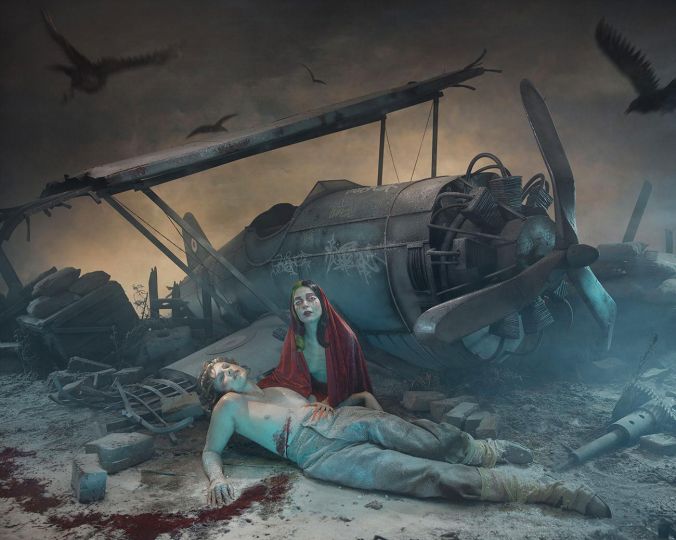Susan Burnstine is an award-winning fine art photographer, curator, writer and educator originally from Chicago now based in Los Angeles. Susan is represented in galleries across the world, widely published throughout the globe and has also written for several photography magazines, including a monthly column for Black & White Photography (UK). Susan has had over 35 solo exhibits internationally, her work is held in numerous museum and private collections and she has had two award winning monographs. Her first, ‘Within Shadows’ (Charta Editions, 2011), earned the Gold award for PX3 Prix De La Photographie Paris in the Professional Fine Art Books category, a Bronze overall and it was also selected for the 2011 Photo Eye Booklist. Susan’s second monograph, ‘Absence of Being’ (Damiani Editore, 2016) earned Best In Show at The 2017 International PhotoBook Awards.
Website: http://www.susanburnstine.com
Instagram & Threads: @susanburnstine
Facebook: https://www.facebook.com/susanburnstinephoto
Black + White Photography Magazine (UK): https://www.gmcsubscriptions.com/product/blackwhite-photography/
Patricia Lanza : How did a childhood trauma affect your path to become a photographer, and specifically develop your unique vision?
Susan Burnstine : As a result of a devastating trauma when I was six, I developed severe night terrors, the results of which unconsciously remained with me for days. Often I would see an image or symbol in my waking life but would not know if it was something real or from my dreams – I had one foot in everyday reality and the other caught in the resonance of my dream world. Early on, my mother came up with a way for me to process the confusion. She taught me to recreate the dreams I had from the night before by translating them through some form of art. I’d awake and she’d hand me a paint brush, sketch book, a piece of clay or whatever creative tool I was drawn to so I could rework and retell my experiences through art. The process helped immensely and it became the core approach to how I create my personal work.
Jump to my thirties. My mother was tragically killed and my night terrors came flooding back, which was unusual for an adult. I needed a means to cope, so I applied what my mother taught me and started to reinterpret my dreams in my chosen form of expression, photography. I tried recreating how my unconscious world appeared via every type of camera known to mankind: 35mm, medium format, large format in addition to every alternative printing method, but nothing worked. Feeling frustrated, I turned to my father for advice. Being an inventor and engineer at one point in his life, he nonchalantly suggested I make my own camera. Initially the idea seemed crazy, but I accepted his challenge and created my first prototype in 2005; about a year after I began the project. To date, I have created 24 homemade cameras and lenses, all of which are technically similar, but have their own special qualities.
PL : What is your creative process in making images?
SB : My creative process is extremely intuitive and unplanned. My process for the black and white work involved journaling night terrors experienced the night before, then going out and shooting. Typically, I’d wander around until something grabbed me. The subject would convey a symbol or metaphor represented in a dream I had the night before and reinterpret what I saw and felt on film.
The process for my color images in Where Shadows Cease is similar, but different. Until 2016, I recalled all of my dreams in black and white, so it made sense to interpret and print the images in the same manner. After a jarring shift in our country in 2016, I began to recall color in my dreams for the first time in my life. The reasons for this shift are unknown but if I was to take a guess, I believe it’s because I had always seen the world in black and white, making that more aligned to what I perceived as reality. Whereas color became escapism from reality after my homeland of America became split by so many factions, which became a new source of trauma for me. Since I have traditionally interpreted what I experience in dreams, the logical conclusion was to start shooting in color to accurately communicate the visual landscape of my unconscious existence.
PL : Discuss your technique using film and special processes in creating the dream-like photographic works? Can you describe how you make your special cameras?
SB : I wanted to authentically recreate how I ‘see’ the world through my own subconscious lens. Conventional, prefabricated cameras simply could not emulate my vision. At one point, I played around with toy camera photography because their dreamy pictorialist was initially intriguing. I enjoyed the look and style of these rudimentary plastic cameras, but they were limited so I began tearing them apart piece-by-piece and modifying them to photograph close-ups, telephoto, etc. Soon after, I started rebuilding these cameras from the inside-out. The process taught me how to create a rudimentary camera, and that catapulted me into building my first homemade camera and lens prototype, built from random household objects, a few vintage camera parts, molded hobby plastic and rubber. Subsequent camera and lens prototypes became one hundred percent homemade.
My cameras only have one to three shutter speeds, one aperture and frequently break since they are mostly held together by Ducco cement, photo tape and glue. Having to work around these limitations has forced me to learn how to harness light in a way that I would not have learned in a conventional camera. It’s also taught me more about all aspects of photography than anything else before.
On average, my cameras can take up to 60-80 hours to create. The cameras are not exactly what might be described as “Swiss Made Precision” so they constantly break and need to be fixed while shooting. As a back-up, I carry multiple cameras when I go out to shoot. Additionally, I always carry a number of DIY tools, tape, Ducco cement, etc. so I can perform emergency surgery on any camera that breaks in the field.
PL : What is the premise about the latest work ?
SB : Since 2016, my work has shifted from the personal to a broader inquiry of common values and beliefs reflected in the social topography of America. My current series, ‘Where Shadows Cease: Resonance of America’s Dream’, showcases iconic landmarks and landscapes that embody the ethos of our country for reasons that are multilayered.
As benefactors of the postwar automobile generation, my parents were near fanatical about traversing every inch of 41,000 miles of pavement laid for their benefit in the 1950s. These highways and byways offered a gateway to freedom, adventure, discovery and an intimate connection promised by every iconic landscape and landmark they happened upon. In hindsight, this enthusiasm might seem naive, but those summer excursions deepened my family’s belief that, as citizens of this country, we were part of something greater than ourselves. I wholeheartedly embraced those beliefs. Whether captivated by the dark beauty of The Badlands or the rich history of Gettysburg, each location stirred within me a sense of shared experience, bound by history, heritage, and hope of the past, present, and future, transcending individual desires and united us as Americans.
My family tragically disintegrated early in my adult life, and in its absence and isolation, I began searching for roots and what unifies us in several of my series. In 2016 divisions and divisiveness in this country severed the foundation of the land I call home, mirroring yet another fundamental loss in my life. Rather than adopting cynicism, the shift inspired me to reconnect with this nation’s beauty and essence by revisiting iconic locations and landscapes across the United States, retracing the memorable road trips of my youth.
In my travels, I delve into the heart of this land using visual metaphor and symbolism to reveal hidden connections within our nations’ collective memory. By seamlessly incorporating universal themes and symbols found in landscapes and cultural sites, I illuminate how these elements embody the enduring spirit and ethos of this country. As this series explores this nation’s rich history and our collective mark on it, it stimulates discourse and offers fresh perspectives on our past, present, and future, united by a reflection of our dreams—American dreams.
PL : You are a successful fine art photographer; your work is represented by galleries, in museum collections, and published monographs? How did this come about? What advice would you give to photographers who want to pursue fine art photography?
SB : Funny story — I never sought out the world of fine art photography, it found me. I had no idea people purchasing limited edition photographs in galleries existed since my education had been in the commercial/editorial/portrait arenas. But as I yearned for self-expression in my work, I fell down the rabbit hole of making my own cameras and started to learn more about fine art photography. I posted my images on a blog (early 2000s, pre-Instagram) and connected with some wonderful photographers. One of incredibly talented photographer I connected with was the Dave Anderson, who was rightfully winning tons of awards and earning endless praise in the fine art and documentary photo world at the time. During a chance meeting at Photo LA, he asked to see my prints. Something told me to put my portfolio of 20 prints in my trunk that day… So when Dave asked to see my work I was able to give him a trunk show – in the trunk of my car! He was so impressed that he snuck my portfolio into his biggest selling gallery at the time, showed the work and they signed me up on the spot. That gallery led to another gallery and another and another… And I have my dear friend Dave Anderson to thank for it all.
Advice: Many people have an illusion that being an artist is a fun, easy, carefree life and once you have a solo show or book, you’re a success, but that’s far from the truth. In actuality, after landing your first gallery rep, that’s just the beginning of the journey. I describe being a fine art photographer as an endless marathon that keeps building with each success rather than a sprint so eat your Wheaties, keep creating work that is meaningful to you and be patient. Building a career in this arena takes time, dedication and a lot of work.
PL : What are your influences and what are you working on currently?
SB : As a child, I was most influenced by the Impressionists. By the age of eight, I tore pages out from books on the great Impressionists and taped them on my bedroom walls. Monet, Seurat, Cassatt, Renoir, Degas—my room was wallpapered with their greatest works. Once I started studying photography, the first photographers who made the deepest impressions were Walker Evans, Dorothea Lange, Bresson and Helen Levitt. In time, the pictorialists deeply influenced my work, but it was the Impressionists that first influenced the way I see.
I am still working on ‘Where Shadows Cease: Resonance of America’s Dream’. The aim is to publish another book once the work feels complete to me. I have also been working on several screenwriting projects that have demanded an immense amount of time, including one that’s about a famous family member that was very close to my heart.
Text & Interview by Patricia Lanza
















